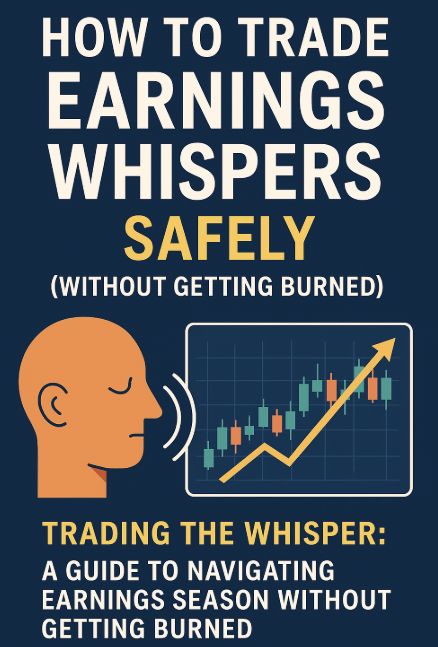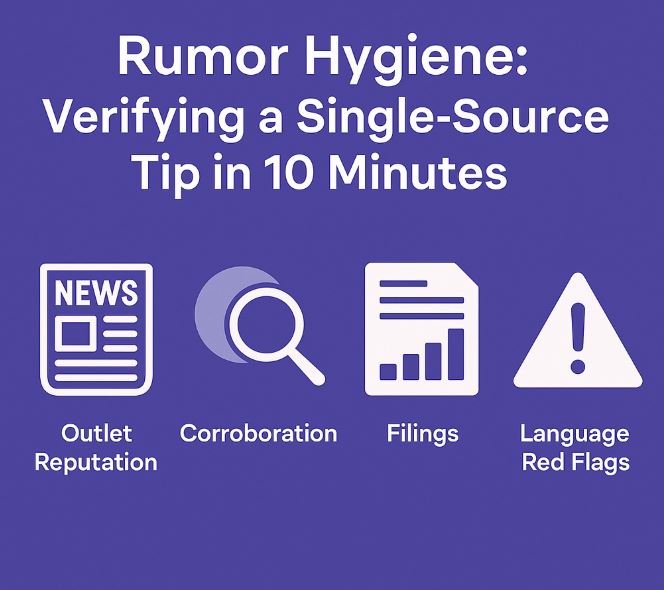Introduction
In the market, the old saying is true: “Buy the rumor, sell the news.” But that only works if you can tell the difference between a credible rumor and market-moving noise. Fortunes are made and lost in the gap between a whisper and a headline. The challenge isn’t just hearing the rumor—it’s having a framework to vet it before the rest of the market does.
Most traders react emotionally. Successful traders operate with a process. This guide provides a clear, three-phase framework to help you systematically analyze rumors, manage your psychology, and make smarter decisions.
The Framework: Detect -> Verify -> Act
Phase 1: Detect the Signal
Before you can analyze a rumor, you have to spot it. This is about filtering the constant stream of information to identify what’s worth a closer look.
1. Look Past the Headline and the Hype
Headlines are designed for clicks, not clarity. Rumors designed to spread fast are often emotionally charged, preying on greed (“This Stock is the Next 10x Winner!”) or fear (“Major Crash Imminent!”).
Your Action: If a piece of information triggers a strong emotional response, pause. That’s a deliberate feature, not a bug. Read the full content. Does the body of the text support the explosive headline, or is it based on vague speculation? Emotional distance is your first analytical edge.
2. Scrutinize the Visuals
“Leaked” screenshots, documents, or charts are classic rumor fuel. In an age of AI and easy photo editing, visuals are no longer proof.
Your Action: Use a reverse image search (like Google Images or TinEye) to find the original source of an image. Zoom in on text or logos—look for inconsistent fonts, strange edges, or pixelation that signals manipulation. AI-generated images often have tells, like misshapen hands, odd backgrounds, or unnatural-looking eyes.
Phase 2: Verify the Credibility
Once a rumor has your attention, the next phase is rigorous due diligence. This is where you separate plausible signals from baseless noise.
3. Follow the Trail: Source & Evidence
An anonymous post on a forum is not the same as a report from a journalist with a track record. Credibility is everything.
Your Action:
- Check the Source: Who is sharing this? Is it an established financial news outlet, a respected industry analyst, or an anonymous account with zero history? Legitimate sources have reputations to protect.
- Check the Evidence: Does the rumor cite verifiable data? Look for specifics: dates, figures, official filings, or named sources. Vague claims like “sources say” or “a person familiar with the matter” are red flags unless they come from a highly reputable news organization (like Bloomberg or Reuters) known for protecting its sources.
4. Use Professional Fact-Checking Tools
Your gut is not an analytical tool. The pros use a suite of resources to cross-reference claims in real time.
Your Action:
- General Claims: Use sites like Snopes, FactCheck.org, or Associated Press Fact Check to debunk widespread misinformation.
- Market & News Flow: Check against institutional newswires like Bloomberg Terminal, Reuters, or Dow Jones Newswires. If a rumor has legs, it will eventually cross their desks.
- Social Media Spread: Tools like trends.google can help track how a rumor is spreading online, giving you a sense of its momentum.
Phase 3: Act with Discipline
Detecting and verifying a rumor is useless without a plan to act—or a plan not to act. This final phase is about risk management and psychological control.
5. Acknowledge and Control for Your Bias
We are all wired to seek out and believe information that confirms our existing positions. If you’re bullish on a stock, you’ll want to believe a positive rumor. If you’re bearish, you’ll gravitate toward the negative.
Your Action: Actively challenge your own assumptions. Ask yourself: “If I had the opposite position, how would I view this rumor?” This mental exercise helps neutralize your bias and allows for a more objective assessment.
6. Treat the Rumor as a Data Point, Not a Directive
A credible rumor is not a guaranteed outcome. It’s a leading indicator—one piece of a much larger puzzle.
Your Action:
- Look for Confirmation: Does the market action support the rumor? Look for unusual options activity, volume spikes, or moves in related assets.
- Size Your Position Accordingly: If you decide to trade based on a rumor, it is a speculative position. Manage your risk by using a smaller position size and setting a clear stop-loss.
- Know Your Exit: Plan your exit strategy before you enter the trade. Will you sell when the news is officially announced? Or when the price hits a certain target?
Key Takeaways: The Trader’s Rumor Framework
- DETECT: Filter out emotionally manipulative headlines and scrutinize visual “evidence.”
- VERIFY: Investigate the source’s credibility, demand hard evidence, and cross-reference with professional tools.
- ACT: Control your personal bias, use the rumor as just one data point, and always manage your risk.
Conclusion
Spotting a rumor before it becomes news isn’t about having a crystal ball—it’s about having a disciplined process. By moving from detection to verification to disciplined action, you can transform market noise into a potential source of alpha.
On Market Rumors Daily, we know the smartest moves are often made in the quiet moments before the crowd arrives. Stay sharp, stay skeptical, and you’ll always stay ahead of the game.
What’s the biggest market-moving rumor you’ve seen play out? Share your story in the comments below!



